If you want to know about the Types of slabs or Permeable concrete or Islamic architecture, please click the link.
Brick is a building material used in construction that is made from clay, concrete, or other materials. It is a small rectangular block that is typically made by molding or pressing clay, and then firing it at high temperatures in a kiln to create a durable and solid material.
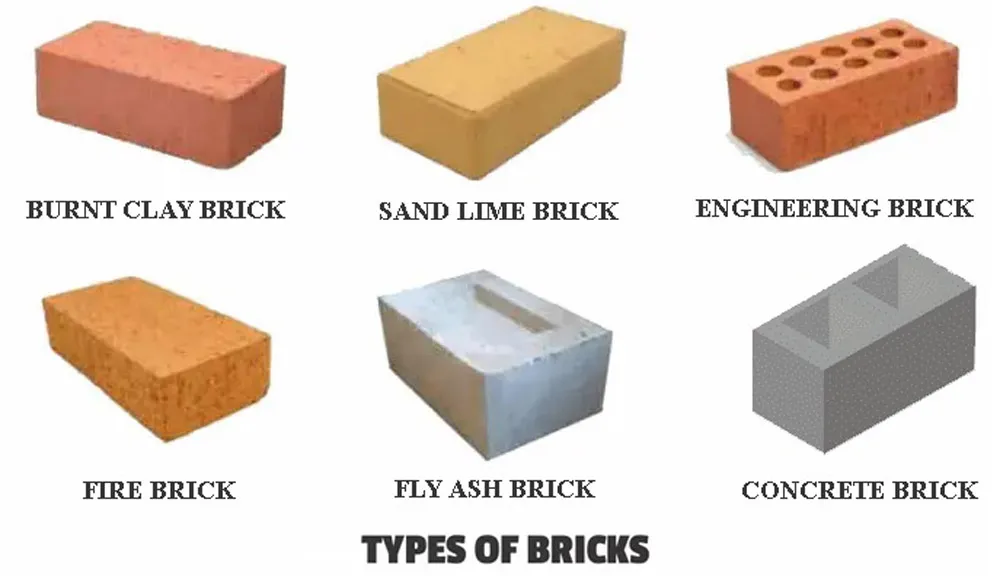
Bricks are commonly used for building walls, pavements, and other structures in both residential and commercial construction. They are known for their strength, durability, and fire-resistant properties, which make them a popular choice in construction around the world. Bricks come in different sizes, shapes, and colors, and can be used for various decorative purposes as well as for their functional properties.
Types of bricks
There are several types of bricks used in construction, including:
1) Clay bricks
Clay bricks are one of the most common types of bricks used in construction. They are made by molding clay into rectangular blocks and then firing them in a kiln at high temperatures to increase their strength and durability. The color of clay bricks can range from reddish-brown to grayish-white, depending on the clay used and the firing temperature.

There are two types of clay bricks: extruded and molded. Extruded clay bricks are made by forcing the clay through a die to create a consistent shape, while molded clay bricks are made by pressing the clay into a mold.
Clay bricks have several advantages in construction. They are durable, fire-resistant, and have good insulation properties, which make them suitable for both load-bearing and non-load bearing walls. They are also easy to work with, can be cut to size, and can be easily combined with other building materials such as mortar and concrete.
However, clay bricks also have some disadvantages. They are heavy, which can make them difficult to transport and handle on construction sites. They are also porous and can absorb moisture, which can cause them to expand and contract with changes in temperature and humidity. This can lead to cracking and weakening of the brick over time. Additionally, the manufacturing process of clay bricks can be energy-intensive and contribute to environmental degradation.
Overall, clay bricks are a popular choice in construction due to their strength, durability, and fire resistance. However, it is important to consider the specific requirements of a construction project when choosing the type of brick to use.
Clay bricks are the oldest type of bricks invented 12000 years ago. Clay bricks are the most common bricks widely used for construction. There are several types of clay bricks available in the market. Based on the hardening process, the bricks can be divided into
- Sun Dried bricks or Unburnt bricks &
- Burnt bricks.
i) Sun dried bricks or unburnt bricks
Sun-dried bricks, also known as unbaked or adobe bricks, are made from a mixture of clay, sand, straw, and water. Unlike traditional fired bricks, sun-dried bricks are not fired in a kiln but are allowed to dry naturally in the sun. This traditional method of brick making has been used for thousands of years, particularly in areas with limited access to fuel or where the cost of firing bricks is prohibitive.

Advantages of sun-dried bricks include their low cost, ease of manufacture, and environmental sustainability. Sun-dried bricks require minimal energy for manufacturing, and the use of locally sourced materials can reduce transportation costs. Additionally, sun-dried bricks have good insulation properties and can help to regulate the temperature and humidity inside a building.
However, sun-dried bricks also have some disadvantages. They are not as strong or durable as fired bricks and can be more susceptible to weathering and erosion. They also have a higher risk of cracking and crumbling, particularly in areas with high rainfall or seismic activity. In addition, sun-dried bricks require careful curing and protection from moisture during the drying process.
Sun-dried bricks are commonly used in construction for low-cost housing, particularly in rural areas. They can be used for both load-bearing and non-load bearing walls and can be finished with plaster or other materials for a more polished appearance. However, their use in construction should be carefully considered based on the specific climate and environmental conditions of the area.
In summary, sun-dried bricks offer a low-cost and environmentally sustainable alternative to fired bricks in certain construction applications. However, their use should be carefully evaluated based on factors such as climate, durability requirements, and availability of materials.
ii) Burnt bricks
Burnt bricks, also known as fired bricks, are one of the most commonly used types of bricks in construction. They are made from a mixture of clay and sand that is molded into shape and then fired in a kiln at high temperatures until they become hard and durable.
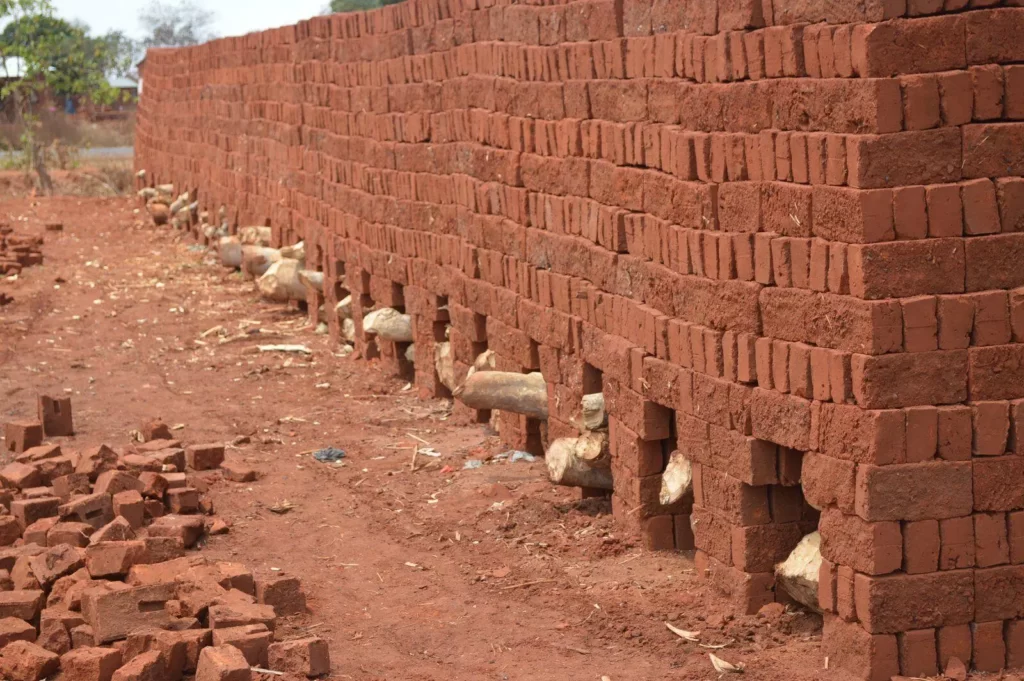
There are different types of burnt bricks available based on the temperature at which they are fired. The temperature can range from 800 to 1200 degrees Celsius, with higher temperatures producing stronger and more durable bricks. The most commonly used burnt bricks are classified as either first-class or second-class bricks, based on their strength and quality.
Burnt bricks have several advantages in construction. They are strong, durable, and have good resistance to weathering and erosion. They also have good thermal insulation properties, which can help to regulate the temperature inside a building. Additionally, burnt bricks are easy to work with and can be cut to size and shape for a variety of construction applications.
However, there are also some disadvantages to using burnt bricks. They are relatively heavy, which can make them difficult to transport and handle on construction sites. They can also be costly, particularly if high-quality bricks are required for load-bearing applications. The firing process for burnt bricks can also be energy-intensive and contribute to environmental degradation.
Burnt bricks are commonly used in construction for load-bearing walls, foundations, and other structural applications. They can also be used for decorative purposes, such as in paving and cladding. However, their use should be carefully considered based on factors such as cost, strength requirements, and availability of materials.
Burnt bricks are either table-molded or ground molded. They are burnt in kilns, autoclaves, or clamps. Burning increases strength and makes bricks more robust. There are four classes of burnt bricks based on their quality.
The classic form of the bricks is burnt clay bricks. These types of bricks are created by pressing the wet clay into the molds than these are drying and firing in the kilns. This material is the oldest building material; these bricks are the solid blocks of hard clay & reddish in color.
These bricks have the best quality and good strength but costly.
Burnt clay bricks are also classified into four types;
First Class Bricks
First-class bricks are a type of burnt brick that is made from high-quality clay and fired at high temperatures. These bricks are classified as first-class based on their strength, durability, and uniformity in size and shape.
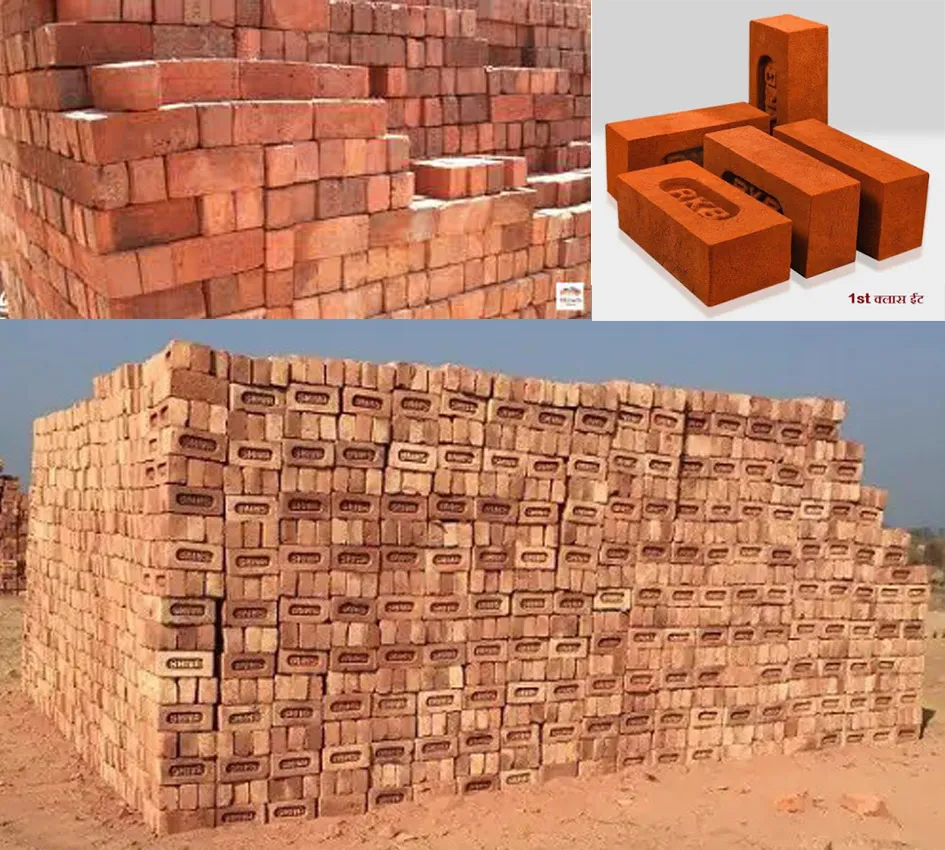
Advantages of first-class bricks include their high strength, durability, and resistance to weathering and erosion. They are also uniform in size and shape, which makes them easy to work with and provides a consistent appearance in construction. Additionally, first-class bricks have good thermal insulation properties, which can help to regulate the temperature inside a building.
However, there are also some disadvantages to using first-class bricks. They can be relatively expensive compared to other types of bricks, particularly if they are required for load-bearing applications. They can also be heavy, which can make them difficult to transport and handle on construction sites. The firing process for first-class bricks can also be energy-intensive and contribute to environmental degradation.
First-class bricks are commonly used in construction for load-bearing walls, foundations, and other structural applications. They are also used for decorative purposes, such as in paving and cladding. However, their use should be carefully considered based on factors such as cost, strength requirements, and availability of materials. In summary, first-class bricks offer high strength, durability, and consistency in construction, but their use should be evaluated based on specific project requirements and conditions.
| Brick | Properties |
| 1. Type | 1. First Class Brick |
| 2. Size | 2. 19 x 9 x 9 cm |
| 3. Crushing Strength | 3. 105 kg/cm2 |
| 4. Edges | 4. Sharp and square. |
| 5. Color | 5. Uniform red or brown. |
| 6.Shape | 6. Standard and uniform (rectangular) |
| 7.Water Absorbing | 7. 15% to 20 % of its self-weight when submerged in water for 24 hours. |
| 8.Surface | 8. Smooth and straight |
| 9. Use of this Brick | 9. Superior work,1 class construction |
Second Class Bricks
Second-class bricks are a type of burnt brick that is made from clay that is of a slightly lower quality than that used to make first-class bricks. These bricks are classified as second-class based on their lower strength and durability compared to first-class bricks.
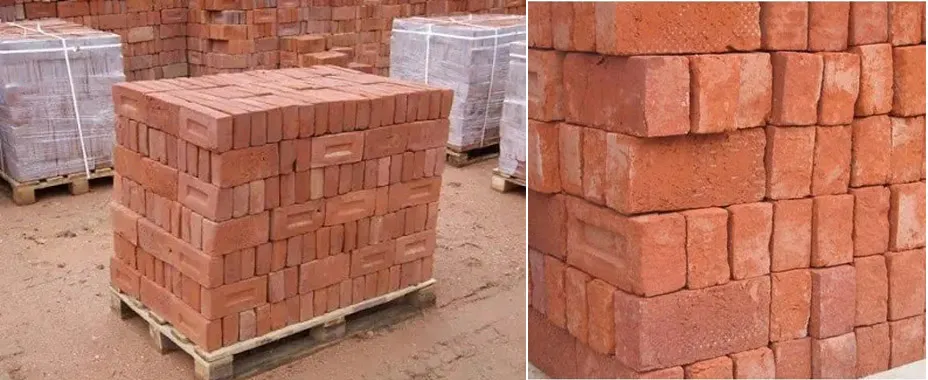
Advantages of second-class bricks include their lower cost compared to first-class bricks, which can make them a more affordable option for certain construction applications. They are also still relatively strong and durable, and can be used for non-load bearing walls and decorative purposes. Additionally, the firing process for second-class bricks is less energy-intensive than that for first-class bricks, which can make them a more environmentally sustainable option.
However, there are also some disadvantages to using second-class bricks. They are not as strong or durable as first-class bricks, and may be more susceptible to weathering and erosion. They can also be less uniform in size and shape, which can make them more difficult to work with and result in a less consistent appearance in construction.
Second-class bricks are commonly used in construction for non-load bearing walls, paving, and other decorative purposes. They can also be used for load-bearing walls in certain circumstances, such as where the structural requirements are not as high. However, their use should be carefully evaluated based on factors such as cost, strength requirements, and availability of materials. In summary, second-class bricks offer a lower-cost option for certain construction applications, but their use should be based on specific project requirements and conditions.
| Brick Feature | Properties |
| 1. Type | 1. Second Class Brick |
| 2. Size | 2. 19 x 9 x 9 cm |
| 3. Crushing Strength | 3. 70 kg/cm2 |
| 4. Edges | 4. Uneven faces may consist of hairline cracks. |
| 5. Color | 5. Uniform color. |
| 6. Water Absorbing | 6. 22% of its self-weight when submerged in water for 24 hours. |
| 7. Crushing Strength | 7. 70 kg/cm2 |
| 8. Shape | 8. Slightly irregular as compare to 1 class |
| 9. Use in | 9. Internal walls |
Third Class Bricks
Third-class bricks are a type of burnt brick that is made from low-quality clay and fired at low temperatures. These bricks are classified as third-class based on their lower strength, durability, and quality compared to both first-class and second-class bricks.

Advantages of third-class bricks include their low cost, which can make them an affordable option for some construction applications. They can also be useful in situations where the structural requirements are not as high, such as in non-load bearing walls and temporary structures.
However, there are several disadvantages to using third-class bricks. They are not as strong or durable as first-class or second-class bricks, and may be more susceptible to weathering and erosion. They may also be less uniform in size and shape, which can make them more difficult to work with and result in a less consistent appearance in construction. Additionally, third-class bricks may not meet building codes or standards in certain jurisdictions.
Third-class bricks are generally not recommended for use in load-bearing walls or other structural applications. However, they can be used for non-load bearing walls, temporary structures, and other applications where the strength and durability requirements are not as high. Their use should be carefully evaluated based on factors such as cost, strength requirements, and availability of materials. In summary, third-class bricks offer a low-cost option for certain construction applications, but their use should be based on specific project requirements and conditions.
| Brick | Properties |
| 1. Type | 1. First Class Brick |
| 2. Size | 2. 19 x 9 x 9 cm |
| 3. Crushing Strength | 3. 105 kg/cm2 |
| 4. Edges | 4. Sharp and square. |
| 5. Color | 5. Uniform red or brown. |
| 6.Shape | 6. Standard and uniform (rectangular) |
| 7.Water Absorbing | 7. 15% to 20 % of its self-weight when submerged in water for 24 hours. |
| 8.Surface | 8. Smooth and straight |
| 9. Use of this Brick | 9. Superior work,1 class construction |
Fourth Class Bricks
Fourth-class bricks are the lowest quality of burnt bricks, made from very low-quality clay and fired at low temperatures. These bricks are classified as fourth-class based on their extremely low strength, durability, and quality compared to first, second, and third-class bricks.

Advantages of fourth-class bricks are very few. They are usually available at an extremely low cost compared to other types of bricks, which can make them an affordable option for certain construction applications. However, the low cost may not always justify their use, as their poor quality can lead to significant issues in construction.
The disadvantages of fourth-class bricks are numerous. They are extremely weak, brittle, and have a high rate of water absorption, making them more prone to damage from weathering, erosion, and freeze-thaw cycles. The low quality of these bricks can result in inconsistent size and shape, which can make them difficult to work with and lead to a less consistent appearance in construction. Additionally, they may not meet building codes or standards in certain jurisdictions.
Fourth-class bricks are generally not recommended for use in construction, particularly for load-bearing walls or other structural applications. They may be used for non-load bearing walls, temporary structures, and other applications where low cost is the primary consideration. However, their use should be carefully evaluated based on factors such as cost, strength requirements, and availability of materials. In summary, fourth-class bricks offer a very low-cost option for certain construction applications, but their use should be based on specific project requirements and conditions.
These types of bricks are also called rejected bricks and are very similar in properties and quality to unburnt bricks. They are over burnt and thus very weak and cannot be used as a building blocks.
They are of non-uniform shape, size, and color. These bricks can be used as a filling material or be ground into a powder to make the wearing coats called Surkhi on the terrace.
2) Sand lime Or Calcium Silicate Bricks
Sand lime or calcium silicate bricks are a type of manufactured brick made from a mixture of sand, lime, and water, with a small amount of cement added for strength. The mixture is pressed into molds and then cured under high pressure and temperature. These bricks are classified as non-fired bricks because they are not burnt in a kiln like other types of bricks.

Advantages of sand lime bricks include their high strength and durability, which make them a popular choice for load-bearing walls and other structural applications. They are also resistant to fire, pests, and weathering, and have good insulation properties, which can help to reduce energy costs in buildings. Additionally, sand lime bricks are uniform in size and shape, making them easier to work with and resulting in a consistent appearance in construction.
However, there are also some disadvantages to using sand lime bricks. They can be more expensive than other types of bricks, which can be a barrier to their use in some construction projects. They also require specialized equipment and expertise for production, which may not be readily available in all areas. Finally, sand lime bricks may not be suitable for certain climates or soil conditions, as they can be more prone to moisture-related issues in some environments.
Sand lime bricks are commonly used in construction for load-bearing walls, paving, and other structural applications. They can also be used for non-load bearing walls, facades, and other decorative purposes. Their use should be carefully evaluated based on factors such as cost, strength requirements, and availability of materials. In summary, sand lime bricks offer a high-strength, durable, and fire-resistant option for construction applications, but their use should be based on specific project requirements and conditions.
3) Concrete Bricks
Concrete bricks, also known as concrete masonry units (CMUs), are precast building materials made from a mixture of cement, aggregates, and water. They are formed in molds and then cured under controlled conditions to achieve the desired strength and durability.
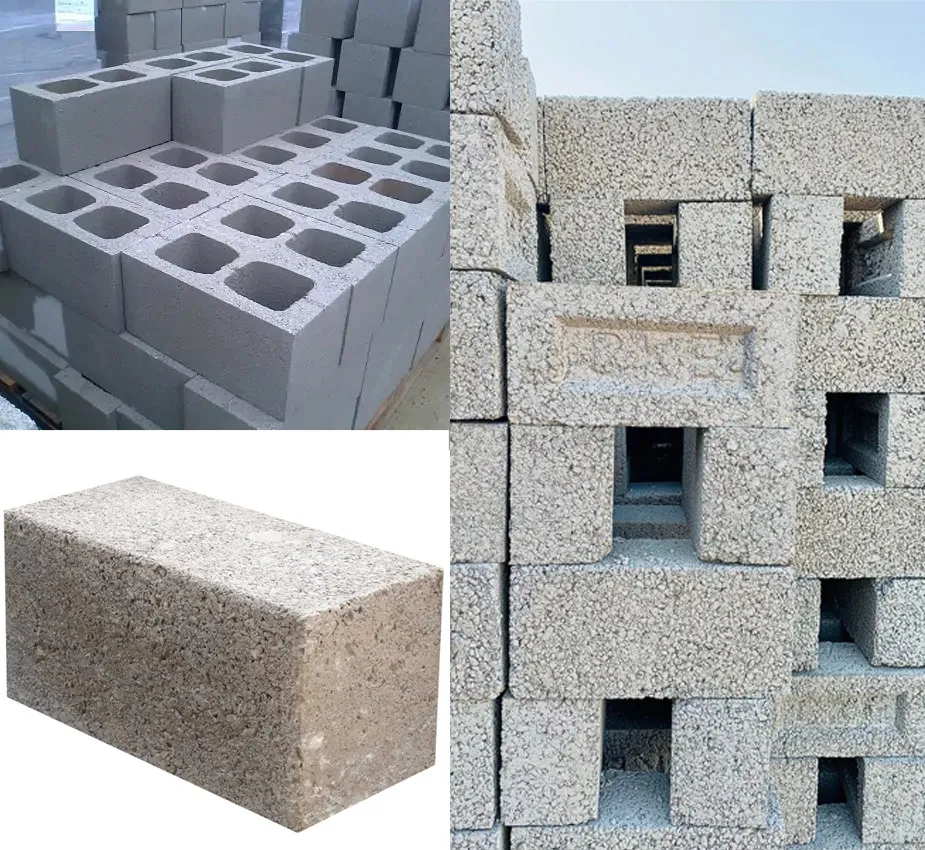
Advantages of concrete bricks include their high strength, durability, and fire resistance, which make them a popular choice for load-bearing walls and other structural applications. They are also resistant to pests, weathering, and moisture, and have good insulation properties, which can help to reduce energy costs in buildings. Additionally, concrete bricks are available in a variety of sizes, shapes, and colors, making them suitable for a wide range of construction applications.
However, there are also some disadvantages to using concrete bricks. They can be more expensive than other types of bricks, particularly in areas where the raw materials are not readily available. They also require specialized equipment and expertise for production, which may not be readily available in all areas. Finally, concrete bricks can be heavier than other types of bricks, which can make them more difficult to handle and transport.
Concrete bricks are commonly used in construction for load-bearing walls, retaining walls, and other structural applications. They can also be used for non-load bearing walls, facades, and other decorative purposes. Their use should be carefully evaluated based on factors such as cost, strength requirements, and availability of materials. In summary, concrete bricks offer a high-strength, durable, and fire-resistant option for construction applications, but their use should be based on specific project requirements and conditions.
4) Fly Ash Bricks
Fly ash bricks are a type of manufactured brick made from a mixture of fly ash, cement, sand, and water. Fly ash is a byproduct of coal-fired power plants and is used as a replacement for clay in the production of bricks. The mixture is pressed into molds and then cured under controlled conditions to achieve the desired strength and durability.
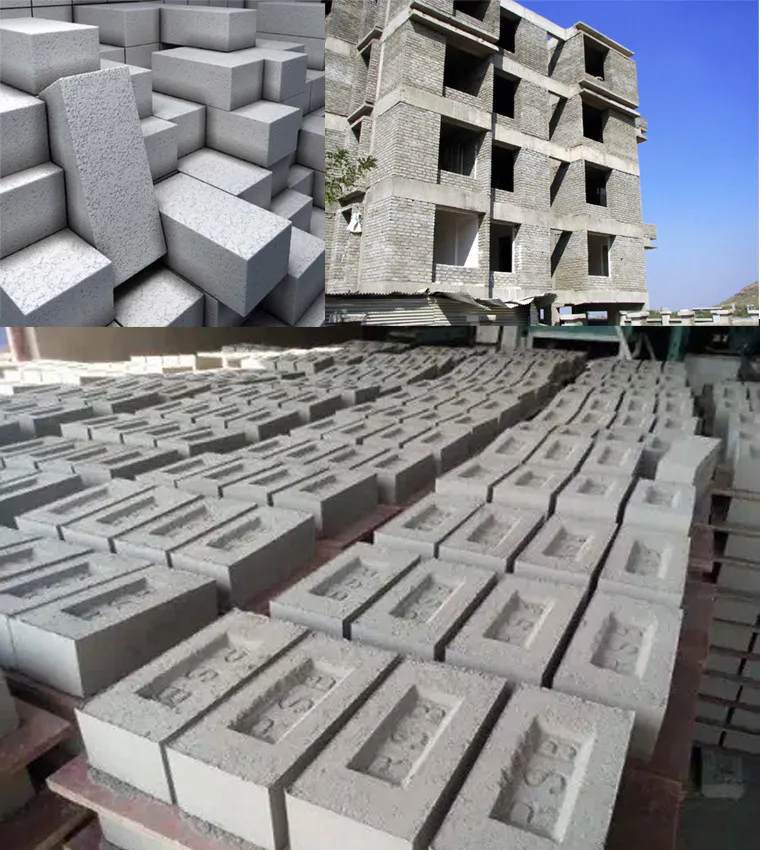
Advantages of fly ash bricks include their high strength, durability, and low cost, which make them a popular choice for construction applications. They are also resistant to pests, weathering, and moisture, and have good insulation properties, which can help to reduce energy costs in buildings. Additionally, fly ash bricks are made from a waste material that would otherwise be discarded, making them an environmentally friendly option.
However, there are also some disadvantages to using fly ash bricks. They may not be as aesthetically pleasing as other types of bricks, as they are typically gray in color. They also require specialized equipment and expertise for production, which may not be readily available in all areas. Finally, the use of fly ash in brick production can raise concerns about the release of heavy metals and other pollutants into the environment.
Fly ash bricks are commonly used in construction for load-bearing walls, retaining walls, and other structural applications. They can also be used for non-load bearing walls, facades, and other decorative purposes. Their use should be carefully evaluated based on factors such as cost, strength requirements, and availability of materials. In summary, fly ash bricks offer a low-cost, durable, and environmentally friendly option for construction applications, but their use should be based on specific project requirements and conditions.
5) Fire Bricks
Fire bricks, also known as refractory bricks, are specially designed bricks that can withstand high temperatures without cracking or crumbling. They are made from materials that are able to resist thermal shock, such as silica, alumina, and fire clay.
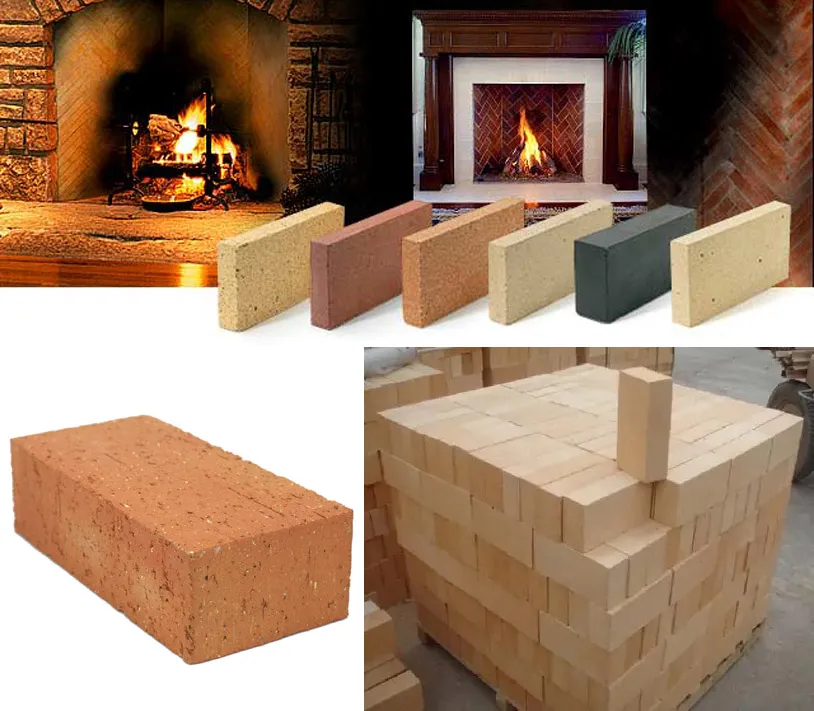
Advantages of fire bricks include their ability to withstand high temperatures, making them ideal for use in applications where heat is a major concern. They are also highly resistant to thermal shock and can withstand rapid temperature changes without cracking or breaking. Additionally, fire bricks are often used in applications where chemical resistance is important, such as in furnaces, kilns, and incinerators.
However, there are also some disadvantages to using fire bricks. They can be more expensive than other types of bricks, and may require specialized installation techniques. They are also typically heavier than other types of bricks, which can make them more difficult to handle and transport. Finally, fire bricks may not be suitable for all types of construction applications, as their specialized properties may not be required.
Fire bricks are commonly used in construction for fireplaces, chimneys, and other heating applications where high temperatures are a concern. They are also used in industrial applications such as furnaces, kilns, and incinerators. Their use should be carefully evaluated based on factors such as cost, temperature requirements, and availability of materials. In summary, fire bricks offer a highly durable and heat-resistant option for construction applications where high temperatures are a concern, but their use should be based on specific project requirements and conditions.
6) Engineering Bricks
Engineering bricks are a type of brick that is made to high standards of durability, strength, and water resistance. They are typically made from dense clay and are fired at high temperatures to achieve their characteristic strength and durability.

Advantages of engineering bricks include their high strength and durability, which make them ideal for use in construction applications where resistance to weathering and erosion is important. They are also highly water-resistant, which makes them suitable for use in applications where exposure to water is a concern. Additionally, engineering bricks are typically larger and heavier than other types of bricks, which can make them more suitable for load-bearing applications.
However, there are also some disadvantages to using engineering bricks. They can be more expensive than other types of bricks due to their specialized properties and manufacturing process. Their dense composition can also make them more difficult to cut or shape, which may require specialized equipment and expertise. Finally, the heavy weight of engineering bricks can make them more difficult to handle and transport, which can increase construction costs.
Engineering bricks are commonly used in construction for applications such as retaining walls, foundations, and load-bearing structures. They are also used in civil engineering projects such as bridges and tunnels, where high strength and durability are essential. Their use should be carefully evaluated based on factors such as cost, strength requirements, and availability of materials. In summary, engineering bricks offer a highly durable and water-resistant option for construction applications where strength and durability are a concern, but their use should be based on specific project requirements and conditions.
Conclusion
In conclusion, bricks are a versatile and widely used construction material that come in many different types and varieties. Each type of brick has its own unique properties and characteristics that make it suitable for specific construction applications. Some of the most common types of bricks include clay bricks, burnt bricks, sand lime or calcium silicate bricks, concrete bricks, fly ash bricks, fire bricks, and engineering bricks.
When selecting a type of brick for a construction project, it is important to consider factors such as cost, strength requirements, durability, water resistance, and heat resistance. It is also important to carefully evaluate the specific requirements and conditions of the project, and to consult with a qualified professional to determine the best type of brick for the job.
Overall, bricks continue to be a popular and practical choice for construction applications due to their versatility, durability, and cost-effectiveness. By understanding the different types of bricks available and their unique properties and characteristics, construction professionals can make informed decisions about the most appropriate type of brick for their projects.